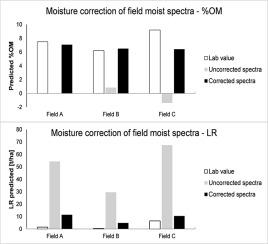Biosystems Engineering ( IF 5.1 ) Pub Date : 2021-02-13 , DOI: 10.1016/j.biosystemseng.2021.01.025 Konrad Metzger , Chaosheng Zhang , Karen Daly

|
Recent development of handheld mid-infrared (MIR) spectrometers holds promising applications for soil analysis. However, problems arise due to water content and other in-situ characteristics, and compatibility with existing spectral libraries and calibrations developed on benchtop instruments. This study examined the potential of handheld MIR for sampling and analysis of field fresh soils. A handheld MIR-DRIFTS instrument (Agilent 4300 handheld FTIR) was used to determine primary soil fertility metrics, specifically, lime requirement (LR) and organic matter (%OM). LR was predicted from handheld collected spectra using calibration models developed from (1) an existing benchtop spectral library and (2) a newly developed model using handheld spectra. Predictions of handheld spectra from the benchtop model exhibited a bias of 2.14 t ha−1, however this was improved (−0.13 t ha−1) when calibrating the model from spectra collected from the handheld instrument. To overcome the adverse effects of moisture on spectral predictions of LR and %OM, moisture correction spectra for seven different moisture classes were applied to soil spectra under field conditions. The moisture correction for the prediction of LR under field moist condition was partially successful and could correct for soils with moisture contents below the permanent wilting point. Prediction of %OM using moisture correction was effective across all moisture categories, and predicted values came within 1% of laboratory values. This research highlights the challenges of handheld MIR in the field, such as finding moisture corrections, practices for field spectra acquisition and the use of spectral libraries and serves as a starting point for future research.
中文翻译:

从台式机到手持式MIR进行土壤分析:预测农业土壤中的石灰需求量和有机物含量
手持式中红外(MIR)光谱仪的最新发展在土壤分析中具有广阔的应用前景。但是,由于水分含量和其他原位特性,以及与台式仪器上开发的现有光谱库和校准的兼容性,会产生问题。这项研究检验了手持式MIR在田间新鲜土壤采样和分析中的潜力。使用手持式MIR-DRIFTS仪器(Agilent 4300手持式FTIR)确定主要的土壤肥力指标,特别是石灰需求量(LR)和有机质(%OM)。LR是使用从以下几个方面开发的校准模型从手持收集的光谱中预测的:(1)现有台式光谱库,以及(2)使用手持光谱新开发的模型。台式模型的手持光谱预测显示出2.14 t ha的偏差-1,但是得到了改善(-0.13 t ha -1)从手持式仪器收集的光谱中校准模型时。为了克服水分对LR和%OM光谱预测的不利影响,在田间条件下将七个不同水分类别的水分校正光谱应用于土壤光谱。在田间潮湿条件下预测LR的湿度校正部分成功,可以校正水分含量低于永久性枯萎点的土壤。使用湿度校正对%OM的预测在所有湿度类别中均有效,并且预测值在实验室值的1%以内。这项研究突出了手持式MIR在现场的挑战,例如寻找湿度校正,现场光谱采集的实践以及光谱库的使用,并作为未来研究的起点。


























 京公网安备 11010802027423号
京公网安备 11010802027423号